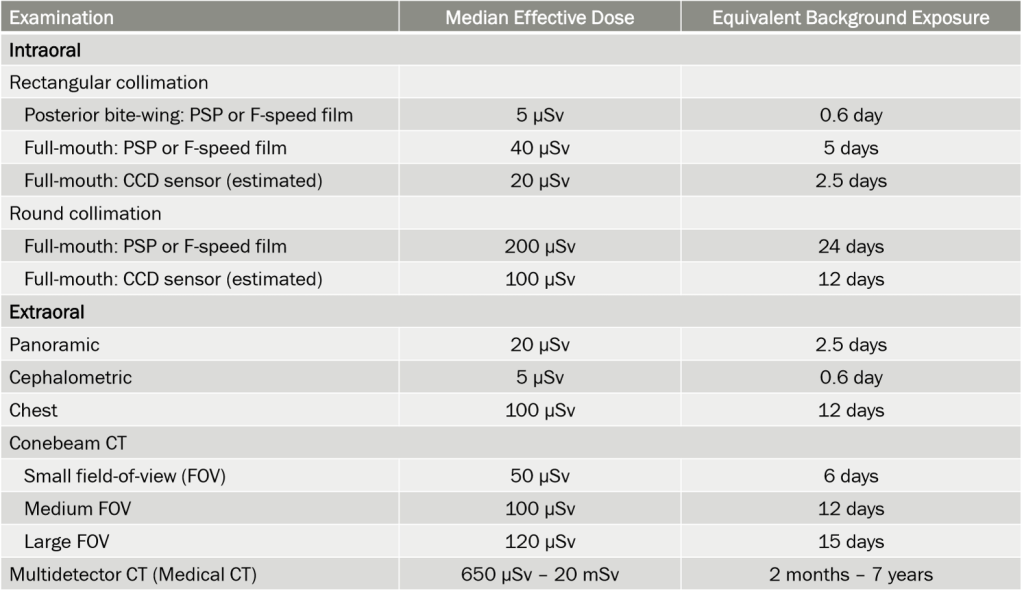Dental X-rays are an essential diagnostic tool that allows dentists to see beyond the surface of your teeth and gums. They help detect issues like cavities, bone loss, and infections that aren’t visible to the naked eye. However, a common concern for patients is the exposure to radiation during these X-rays. Overall, while they do involve a small amount of radiation, modern dental practices are designed to minimize exposure and ensure patient safety. In this article, we’ll explain the types of radiation involved in dental X-rays, the safety measures in place, and why the benefits of getting dental X-rays often outweigh the risks.
How Much Radiation Does a Dental X-Ray Give You?
It’s important to note that radiation is all around us. The average person is exposed to background radiation every day from natural sources like the sun, soil, and even certain foods. In fact, the radiation from dental X-rays is a small fraction of what we’re exposed to in our daily lives. The table below helps illustrate this; the average effect of dental X-rays spread out over the year is 0.007mSv which is less than 1% of the average effect of natural background radiation.

To further put things into perspective:
- The radiation from a single dental X-ray is about 1/10th the dose you would get from a cross-country flight.
- The effective dose of radiation from a full set of dental X-rays is roughly equivalent to 2-3 days of background radiation. This is much less than most other types of medical X-rays.

How do Dentists Quantify Radiation Exposure?
Dosimetry is the science of measuring radiation exposure. For dental X-rays, the amount of radiation absorbed by your body is minimal compared to other types of medical imaging. The exposure is measured in units called Sieverts (Sv).

For perspective:
- A single intraoral x-ray (like a bitewing) exposes you to about 5 microsieverts (µSv), which is equivalent to less than a day of natural background radiation.
- A full-mouth series of x-rays may expose you to around 100 µSv, equivalent to about 12 days of background radiation.
- A cone-beam CT scan, used for more complex diagnoses, may expose you to around 100 µSv, similar to the radiation from a short airplane flight.
These doses are far lower than other medical imaging techniques, such as a chest CT scan, which can expose you to much higher levels of radiation.
What Damage Could Dental X-Ray Radiation Cause?
Dental X-rays use a type of radiation known as ionizing radiation. Ionizing radiation has the ability to interact with human tissues, causing changes at the cellular level. There are two main types of interactions that occur when radiation enters your body: direct and indirect actions.
- Direct actions occur when the energy from X-ray photons directly ionizes molecules in your body, forming free radicals.
- Indirect actions happen when radiation interacts with water in the body, producing free radicals that can then interact with your cells. This type of interaction is most common with dental x-rays.
Both types of actions can cause DNA damage, but it’s important to understand that your cells have mechanisms to repair this damage. The levels of radiation from dental X-rays are so low that the body typically repairs itself without long-term effects.
How Dentists Minimize Radiation Exposure
Dentists follow strict guidelines to minimize your exposure to radiation. They apply the principle of ALARA (As Low As Reasonably Achievable), which means they aim to reduce radiation doses as much as possible while still obtaining the necessary diagnostic information. Some of the ways they do this include:
- Using digital X-rays or high-speed film, which require less radiation than traditional methods.
- Employing rectangular collimation, which narrows the x-ray beam and reduces radiation exposure to surrounding tissues.
- Providing patients with lead aprons and thyroid collars to shield sensitive areas from unnecessary radiation.
- Only prescribing an x-ray when medically necessary such as during root canals or to check if you need a filling.
Is There a Risk of Cancer from Dental X-Rays?
While it’s true that ionizing radiation can increase the risk of cancer, the radiation dose from dental x-rays is so low that the risk is extremely small. Studies show that dental x-rays contribute only a minuscule fraction to a person’s overall cancer risk. By following recommended guidelines for dental radiography, your dentist ensures that x-rays are only used when necessary and that the potential benefits to your oral health far outweigh any risks.
Conclusion
Dental x-rays play a crucial role in diagnosing and treating oral health issues. While they do involve a small amount of radiation, modern dental practices are designed to minimize exposure and ensure patient safety. The key takeaway is that the benefits of dental x-rays — in terms of preventing and detecting serious dental conditions — far outweigh the minimal risks associated with radiation. Always feel free to discuss any concerns with your dentist to make informed decisions about your oral health care.
Disclaimer
The contents of this website, such as text, graphics, images, and other material are for informational purposes only and are not intended to be substituted for professional medical advice, diagnosis, or treatment. Nothing on this website constitutes the practice of medicine, law or any other regulated profession.
No two mouths are the same, and each oral situation is unique. As such, it isn’t possible to give comprehensive advice or diagnose oral conditions based on articles alone. The best way to ensure you’re getting the best dental care possible is to visit a dentist in person for an examination and consultation.
SAVE TIME AND MONEY AT ANY DENTIST

Less dental work is healthier for you. Learn what you can do to minimize the cost of dental procedures and avoid the dentist altogether!

